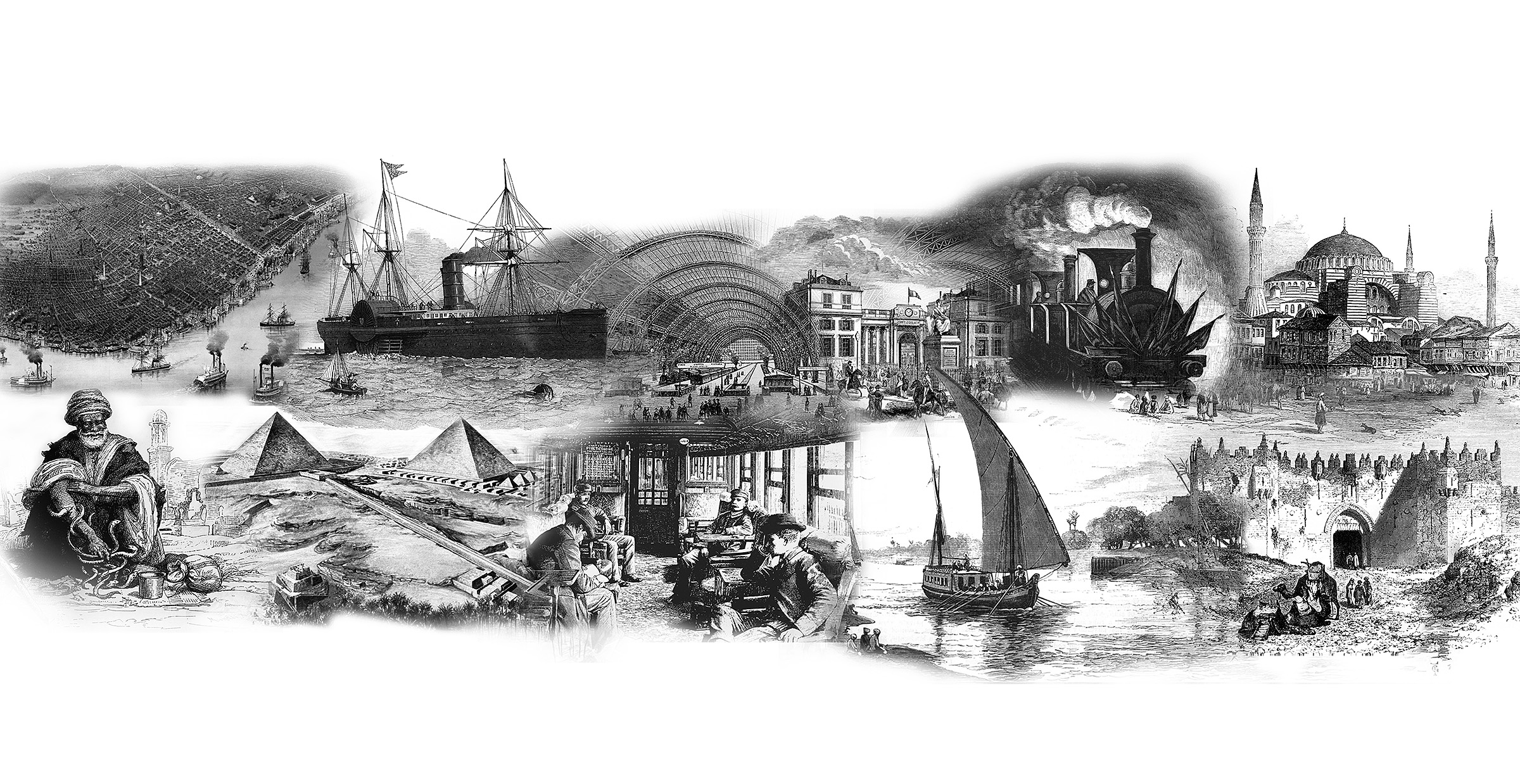
David Dorr's Window East
Like other “Grand Tour” travelers of the 1850s, David Dorr visited Europe, Egypt and Palestine. But unlike others, Dorr did not travel freely. His book, A Colored Man Round the World, is the only known account of Middle East travel by an American slave.
Sometime in the spring of 1853, an American traveler named David Dorr rode a camel out of the deserts of southern Palestine.
Superficially, this is not such an unusual account. Europeans and Americans had long been exploring—and writing about—this part of the world. More such writing would follow, partly inspired by Mark Twain’s The Innocents Abroad, published in 1869: this witty, much-celebrated travel memoir helped fuel a Western fascination for visiting (as well as shaping and colonizing) the Holy Land that has never really abated.
By contrast, Dorr’s memoir of his three-year journey around parts of Europe and the Middle East, self-published more than a decade before Twain’s, is virtually forgotten today. Few quote his witticisms or commend his insights. The extraordinary story of his journey—and his life—remains almost completely unknown.
The title of Dorr’s book gives a clue as to why this might be. He called it A Colored Man Round the World.
African American social reformers including Harriet Jacobs, William Wells Brown and, most famously, Frederick Douglass had traveled to Europe before Dorr, lecturing and publishing. Others had been as far as Egypt.
But as far as we know, David Dorr was the first African American ever to visit Jerusalem.
He did not travel of his own free will. In this period before the American Civil War, and before the Emancipation Proclamation of 1863, Dorr—like some four million of his compatriots—was enslaved. He was forced to accompany his owner.
Dorr was born in New Orleans in 1827 or 1828 (he had no birth certificate, but we can deduce the date from later evidence), enslaved to a business owner named Cornelius Fellowes. He described himself—and was described by others—as a “quadroon,” a now-archaic term meaning that he was one-quarter black, born of one white parent and one parent of mixed white and black background. He refers to his mother being enslaved in Louisiana, but he doesn’t name her, and we have no way of identifying either her or Dorr’s father.
Although Fellowes legally owned Dorr, the practical nature of their relationship, and how it was expressed, seems to have had more nuance than might be expected. Dorr says Fellowes treated him “as his own son” and “as free a man as walks the earth”—though we should be wary of taking such words at face value.
When Dorr was in his mid-20s, Fellowes brought him on an extended world tour. They probably left New Orleans in early 1851 and most likely took ship from New York to cross the Atlantic: Dorr records his arrival in Liverpool, England, on June 15 that year. After London they crossed to France and then meandered through Belgium, the Netherlands, Germany, Switzerland, Italy, Greece, Turkey, Egypt, Palestine, Syria and Lebanon, often with long stopovers. Paris became a favorite haunt. Significantly, Dorr’s skin color seems to have been pale enough for him to “pass” as white. Their return ship departed Le Havre, France, on September 2, 1853.
Back in New Orleans, everything changed. As Dorr wrote: “When we returned, I called on this original man [a sarcastic reference to Fellowes] to consummate a two-fold promise he made me, in different parts of the world, because I wanted to make a connection, that I considered myself more than equal in dignity and means, but as he refused me … I fled from him and his princely promises.”
In other words, Fellowes vowed to free Dorr, but reneged. Astonishingly for any enslaved person at that time, Dorr then escaped, “reflecting on the moral liberties of the legal freedom of England, France and our New England States, with the determination to write.”
Perhaps helped by the clandestine network of guides and safe houses known as the Underground Railroad, Dorr made it to Ohio, where slavery was illegal. He lived as a clerk, lecturing and, in 1858, paying to self-publish his book. During the Civil War, he enlisted but was wounded in battle, returned to New Orleans in failing health, and there he died, probably in 1872, aged in his mid-40s.
But for his book, we wouldn’t know Dorr at all. We have nothing from Fellowes against which to compare his account. The purpose of their long journey is never made clear, but in a literary act of deep resonance, considering the erasure of Black perspectives and Black lives in America before (and after) the Civil War, Dorr almost entirely erases Fellowes from his narrative. Dorr describes his journey as if it were his alone: He is the one dining grandly; he is the one selecting itineraries and ordering transportation. “I went down to have my bill made out,” he wrote of his Liverpool hotel. In Germany: “I declined all invitations and got a carriage.” In Italy: “Having arrived and hoteled myself, I ascertained where the races were.” This might be the truth. Perhaps Dorr did pay the bill. But it might not be the whole truth. Quietly and deliberately, Dorr claims in writing the agency denied him in life.
Moreover, where Dorr does include Fellowes, it is generally to mock him as clumsy or socially awkward. Dorr shows acute sensitivity to power relations, yet he subverts them not through righteous anger but subtly, by recreating himself on the page as a refined and tasteful gentleman of leisure. He invents and inhabits a persona that can wield the cultural capital that he himself, back home in New Orleans, could not.
In this way, Dorr created a genre.
“A Colored Man Round the World appropriates the forms and structures of Anglo-American travel writing so completely that what we have is a superb case of literary doublespeak: the blackest of texts in whiteface,” writes Malini Johar Schueller, professor of English at the University of Florida, in her 1999 introduction to what is still the only modern edition of Dorr’s book.
In contradistinction to “blackface,” a theatrical tradition in which white performers wore clownish makeup to appear as and usually caricature black people, Schueller’s idea of “whiteface” has Dorr adopting a privileged air of urbane sophistication to undermine his owner and, with him, other wealthy American travelers. The veneer may be jokey, but the purpose reads sharply. Dorr is “writing for an American audience, mostly a white audience, and fashioning a self that is radically different from perceived ideas about African Americans, especially slaves,” Schueller told me. By assimilating, or even by just affecting assimilation, Dorr can quote Shakespeare and Byron. He can speak French. He can comment with insight on social issues of the day. Schueller pinpoints this unsettlingly implicit critique of white literary style as a reason scholars and critics have shunned Dorr over the years.
Most of the book is devoted to Dorr’s travels in Europe, where he encounters social contexts radically different from back home. One example: “26th of September [1851], and I am at the capital of Holland … I just dined with a king. The father of the Queen ... is putting up here [at my hotel] … He is going out—he bows to me.”
The significance of a king bowing to a slave—and of a white man bowing to a “quadroon”—would not have been lost for a moment on Dorr’s readers. It is one of many such anecdotes throughout the book, whose very title reflects Dorr’s almost gleeful deconstruction of power and privilege through a juxtaposition that would have seemed both striking and dissonant. Amid overwhelming disadvantage, and between the covers of what is ostensibly a travel diary, this self-confident and sometimes even cocky young man offers a pointed commentary on American racial prejudice.
He also seems to have had a whale of a time. He describes flirting with hotel maids (presumably white); attending high-class balls; viewing fine art; hobnobbing with nobility and having a hundred other adventures that would be barred to him at home.
But when he reaches the Muslim world, a harder, more judgmental tone takes over as Dorr’s manufactured identity coalesces further. In Constantinople (modern Istanbul)—whose “immense number of steeples, towers and minarets; … [made] the fairest sight I ever beheld”—Dorr adopts a common Western literary trope in describing the Ottoman sultan Abdulmejid as “a weak looking man … surfeiting on the fat of the world.”
His internalization of a Western notion of supremacy deepens in Egypt. In Alexandria he is disgusted by the food. Cairo he describes with a backhanded compliment as “a still magnificent city for its age.” He scoffs at local guides’ descriptions of sights (“I could plainly see that his information was merely traditionary, without the least shadow of history for support”), and he rails against the crew on his Nile riverboat and others when they ask for tips. There is even outright racism: “To believe what an Arab says when trying to sell anything, would be a sublime display of the most profound ignorance.”
Why the shift in attitude? Schueller criticizes Dorr for “buying into well-established stereotypes [that would] bring him closer to white status.” Further clues lie in an unusual chapter that delivers the book’s weightiest message. In a lengthy evocation of Egyptian prowess in civilization-building, Dorr reflects on historical context and Black identity. He discusses Alexander the Great, the Ptolemaic dynasty and Biblical history, painting one particularly stark picture: “In going to these Pyramids, one walks over a pavement of dead bodies. I sunk in the sand, one hundred yards from the pyramid of Cheops, and my foot caught in the ribs of a buried man, which I afterwards learned to be a mummy.… [T]he whole plain, from the Pyramids to Cairo, some six or seven miles, is macadamized with dead Egyptians.”
University of South Carolina professor Scott Trafton writes of this passage: “Dorr intrudes violently into a history from which he was being just as violently excluded, and yet he presents his understanding of the racialized issues crunching under his feet as complex and curiously bittersweet.”
It is a pivotal moment. Dorr calls the ancient Egyptians “the ancestors of which [I am] the posterity.… Egypt was a higher sphere of artistical science than any other nation … the Egyptians … [were] men with wooly hair, thick lips, flat feet and black.”
Dorr’s horizons have expanded massively. In America, he was enslaved and discriminated against as black. In Europe, he not only encountered social equality, but he was not even seen as black at all. Then Africa presented a social context where Black achievement and Black cultural pride were a norm, and he felt deep affinity.
But extended travel seems also to have undermined Dorr’s debonair persona. The security and enlightenment that Egypt offered exposed a different prejudice, this time against Arabs.
From here, it’s as if something breaks in his resolve. Having devoted more than 180 pages to the journey so far, Dorr rushes through the remainder of his trip in a bad-tempered eight pages.
After a long camel ride across the desert into Palestine, Dorr harrumphs when authorities in Hebron refuse entry to the town’s mosque. Lodged in a Jerusalem convent, he offers a wry, Twain-like comment on the economics of pilgrimage: “They make no charges against a pilgrim, but no pilgrim can come here unless rich, and no rich man will go away without giving something to so sacred a place.” He announces a visit to Bethlehem, but then he describes the tomb of Lazarus and Bethel, which are far in the other direction: Was he lost, or misled? A local guide is “impudent.” Jerusalemites are “ignorant.”
Finally, having stayed 17 days, Dorr leaves Jerusalem,
“never wishing to return.” He hurries to Damascus, which he leaves undescribed, before speeding through Lebanon to Acre and then Jaffa, where he—presumably with Fellowes—departs for home.
Near the end of this rushed sequence comes an apparently minor episode that encapsulates Dorr’s singular style. He wrote: “The same evening I camped at Jericho.… We took a bath in the Jordan [River], and tried some of its water with eau de vie, and found it in quality like Mississippi water.”
Centuries of yearning in African American poetry and song evoke a remembrance of “Zion” in exile, often centered on the liberating experience of flowing water. Countless images link biblical baptism with both spiritual and material freedom from enslavement. Here is Dorr, a literal slave, presumably alongside an older man who claims legal ownership over him, surrendering his body to the flowing water of a river that holds profound metaphorical significance for his own culture, religion and political identity—and he calls it merely “taking a bath.”
Then he drinks from the very river of liberation and, with a devastating comparison, anchors his own emancipation to the lives of his readers in America, beside another flowing river. With one line Dorr nods to his white audience, who might grin (or tut) at the irreverence, and simultaneously broadcasts a message of solidarity and hope to African Americans. He also, perhaps unwittingly, exposes the contradictions within his literary affectation: Dorr, Schueller observes, “claims an authority over the landscape that he, as a Black person with origins in Egypt, [feels he] can claim,” yet he vilifies the Arabs who live there— as much as, presumably, his owner might have done.
If “cool” began with African Americans assuming a front of ironic detachment as a personal rebellion against overwhelming oppression, concealing the emotional impact of injustice behind a persona created to disarm, David Dorr is a pioneer of cool. He asserted his authority to speak, despite enslavement. He shamed American readers by demonstrating the abnormality of what they took as normal. Laconic, funny, literate, sharply observant—and also arrogant and prejudiced—Dorr’s writing speaks as loudly to our century as to his.
You may also be interested in...

Art Biennial Reviving the Ancient City of Bukhara, Uzbekistan
History
Culture
Uzbekistan’s inaugural biennial reactivates an ancient stop on the Silk Road through artworks jointly created by international and Uzbek artists.
‘Home’: Arab American National Museum Celebrates 20th Anniversary
Arts
Arab American National Museum Director Diana Abouali says the facility—which is marking its 20th anniversary in 2025—in Dearborn, Michigan, has aimed to create a home for Arab Americans by preserving and presenting the history, culture and contributions of Arab immigrants as well as their native-born children and grandchildren.
Grand Egyptian Museum: Take a Tour of the New Home for Egyptian Artifacts
Arts
The Grand Egyptian Museum has officially opened its doors, revealing treasures from the ancient Egyptians and their storied past.